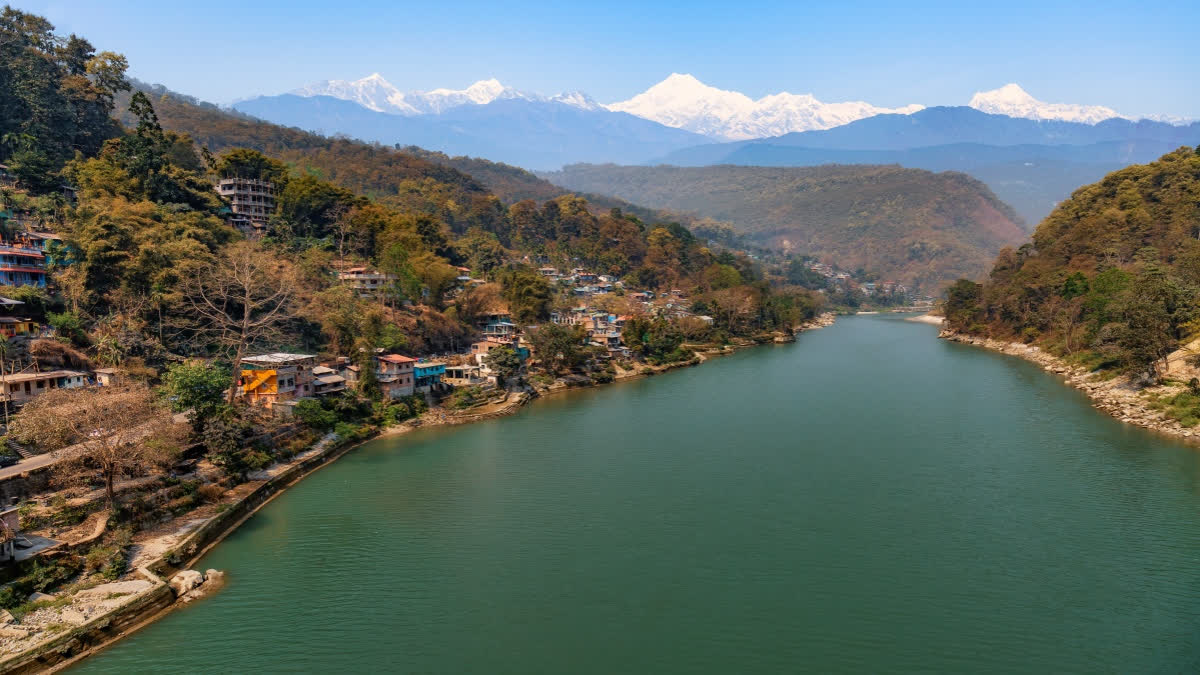New Delhi: India may find itself in a tight spot as Bangladesh once again turns to China for help with the Teesta River management project, a move that could further complicate New Delhi-Dhaka relations.
The Teesta water-sharing pact, stalled for years due to political sensitivities within India, has been a major point of contention between the two South Asian neighbours. With Beijing now being actively considered as a partner, India faces the challenge of balancing its diplomatic ties with Bangladesh while countering China's growing presence in the region.
According to reports in Bangladesh media, on January 29, the Bangladesh Water Development Board (BWDB) and Chinese state-owned PowerChina signed an extension to a memorandum of understanding (MoU), pushing the Teesta River Comprehensive Management and Restoration Project (TRCMRP).
According to one media report, under the deal, PowerChina will prepare a concept paper by December and conduct a feasibility study in 2026. After that, the Teesta project will be finalised.
"We have agreed to give China two years to complete the two tasks under the project," The Daily Star quoted Environment Adviser Syeda Rizwana Hasan as saying.
This development comes after India had announced that it would be sending a technical team to the eastern neighbour to study the Teesta management project following the visit of then Bangladesh Prime Minister Sheikh Hasina to New Delhi in June last year.
"Fifty-four common rivers connect India and Bangladesh," Prime Minister Narendra Modi had said during a joint address to the media along with Hasina following delegation-level talks. "We have been cooperating on flood management, early warning, and drinking water projects. We have decided to start talks at the technical level for the renewal of the Ganga Water Treaty of 1996. A technical team will soon visit Bangladesh to discuss the conservation and management of Teesta River in Bangladesh."
This had come even as India and Bangladesh are yet to share an agreement on the Teesta waters sharing issue.
What is the Teesta water-sharing issue?
The Teesta River, one of the major transboundary rivers in the region, flows through the Indian states of Sikkim and West Bengal before entering Bangladesh. It plays a crucial role in the agriculture and livelihoods of millions of people in both countries. However, the distribution of its waters has been a contentious issue between India and Bangladesh for decades, causing significant political and diplomatic tension.
The Teesta River’s flow into Bangladesh during the lean season is the main point of contention between India and Bangladesh. Hundreds of thousands of people’s livelihoods are impacted by the river, which drains 2,800 sq km of Bangladesh and flows through the floodplains of Sikkim.
Out of its total length of 414 km, the Teesta River flows for about 151 km through Sikkim, nearly 142 km through West Bengal, and the final 121 km through Bangladesh. The river had an average historical flow of 7932.01 cubic metres per second (cumec) maximum and 283.28 cumec minimum at Dalia, upstream of the Teesta Barrage in Bangladesh.
India and Bangladesh were close to reaching a deal on the Teesta waters issue during then Prime Minister Manmohan Singh’s visit to Dhaka in 2011. But West Bengal Chief Minister Mamata Banerjee did not accompany Singh and the deal could not be signed at the last moment. Banerjee is opposed to the deal, as she is of the view that the water of the Teesta River is decreasing drastically. The river facilitates irrigation of 1.20 lakh hectares of highly arable land in northern West Bengal.
But then again, following Hasina’s June 2024 visit, a joint document issued by the two sides stated: "Recognising the importance of water resource management in our bilateral relationship, we will continue to engage in prioritising the exchange of data and formulating the framework for interim water sharing based on the recommendations of the Joint Rivers Commission. We welcome the formation of a Joint Technical Committee to initiate discussions for the renewal of the Ganges Water Sharing Treaty of 1996. As part of our development cooperation, we will also undertake conservation and management of Teesta River inside Bangladesh with Indian assistance within a mutually agreed timeframe."
So, what is the TRCMRP?
The Teesta River is vital for irrigation, drinking water, and sustenance of biodiversity in the regions it flows through. However, the river faces significant challenges such as seasonal water scarcity, sedimentation, and pollution, making its conservation and management a critical issue for the Bangladeshi government.
The TRCMRP was initiated by the Bangladesh government for water resource management, flood control and management, ecosystem restoration, pollution control and community engagement. The objectives include ensuring a sustainable and equitable distribution of water for agricultural, industrial, and domestic use; implementing measures to prevent floods during the monsoon season and managing water flow during the dry season; restoring the riverine ecosystem to support biodiversity and maintain ecological balance; reducing pollution levels through strict regulations and promoting cleaner production practices in industries; and involving local communities in conservation efforts and ensuring their livelihood is supported through sustainable practices.
What was India’s decision to send a technical team seen as significant?
The Bangladesh government, in collaboration with China, initiated the TRCMRP to address the persistent water crisis of the Teesta River. During Chinese President Xi Jinping’s visit to Bangladesh in 2016, Beijing committed to memorandums of understanding (MoUs) valued at $24 billion, including one focused on river management alongside numerous others based on mutual benefit and equality. China promised technical assistance for land reclamation efforts in response to climate change impacts on both sea and river fronts.
In line with these agreements, the Bangladesh Water Development Board and PowerChina signed an MoU to collaborate on water sector projects in Bangladesh. A feasibility study on the Teesta River was conducted, following which PowerChina submitted the TRCMRP report. This report was subsequently approved on May 30, 2019. However, for New Delhi, it was a matter of concern as it was seen as China expanding its influence in India’s immediate neighbourhood. Following Hasina’s visit, observers were of the view that by taking the decision to send a technical team to study the TRCMRP, India has checkmated Bangladesh.
What happens now that Bangladesh has approached China again?
"The masterplan that PowerChina came up with expired in December 2024," Sheikh Rokon, Secretary-General of the Dhaka-based civil society organisation Riverine People, told ETV Bharat over the phone. "The interim government has put forward two conditions to China for extension of the MoU. One is that the masterplan should be finalised by December 2025. The second is that public hearings should be conducted so that people living on the banks of river can voice their concerns and expectations.”
Rokon is of the view that before the implementation of the TRCMRP, it is important that New Delhi and Dhaka sign the long-pending bilateral agreement since India is the upper riparian country.
"There are two barrages in India and Bangladesh within 70 km of each other on the Teesta River," he explained. "There is the Gajoldoba Barrage in India (in West Bengal) that diverts water to canals that lead to different regions of within the country. The Duani Barrage in Bangladesh is virtually non-functional because of lack of water."
Though Bangladesh has approached China again for the implementation of the TRCMRP, Rokon, however, is of the view that the masterplan should be a multilateral one at the end of it.
"There should be India because the river flows from within its territory," he said. "There should be China because of its technical expertise. And then there should be the World Bank (WB) and the Asian Development Bank (ADB) because they have the ecological safeguard measures in place."
Rokon added that the Bangladesh government should take the ecological issues involved and the cost-effectiveness of the project into consideration. However, according to an Indian expert on Bangladesh's economy and politics, Dhaka approaching Beijing again for the project will be a cause of concern for New Delhi.
"The Teesta River basin is very close to the ‘Chicken’s Neck’ that connects northeastern India to the rest of the country and the Doklam region in Bhutan," the expert told ETV Bharat on the condition of anonymity. "We have been telling Bangladesh not to go ahead with China for implementing the project."
In fact, media reports suggest that Chinese officials are already present at the site of the project following the signing of the latest agreement between Dhaka and Beijing.
"We know that when the Chinese come, they will be involved in espionage activities," the expert said. "There will be security threats in the international border areas of West Bengal, Bihar, northeastern India as also Bhutan and Nepal. After the interim government came to power in Dhaka (in August 2024), Pakistan has been training Bangladeshi security forces. Now, a new Bangladesh-China-Pakistan axis is being formed."



